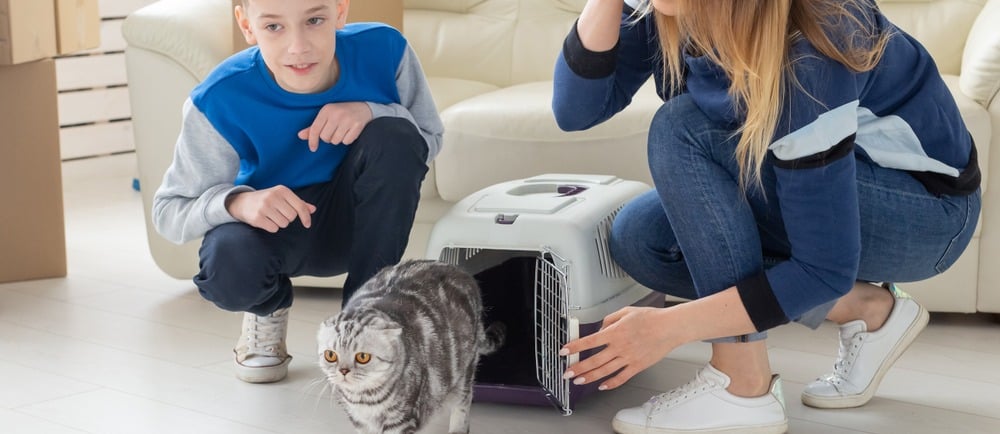items chosen one by one so you have the best option and save money on amazon (Links in articles)
How to Transition Pets to a New Home Without Anxiety
Moving to a new home can be exciting for humans—but for pets, it can be overwhelming and stressful. New smells, unfamiliar layouts, strange sounds… all of it can trigger anxiety, confusion, or even behavioral issues. But with the right strategy (and a lot of patience), you can help your pet transition smoothly and even learn to love their new space. Here's how to relocate your dog or cat with minimal stress—for them and for you.
6/27/20252 min leer


🐾 1. Prepare in Advance — Not on Moving Day
Don’t wait until moving day to think about your pet’s comfort. Start preparing weeks before the move:
✔️ What to do:
Keep routines (feeding, walking, playtime) as normal as possible
Start packing gradually to reduce chaos
Let your pet explore moving boxes and supplies
🎁 Tip: Create a "pet moving kit" with food, toys, bedding, and comfort items.
👉 Get everything your pet needs for a stress-free move on Amazon
🚗 2. Use the Right Travel Equipment
Whether you're moving across town or across the country, secure, comfortable travel is essential.
For dogs and cats:
Sturdy carriers or crates
Seatbelt harnesses
Travel bowls and water bottles
Calming sprays or pheromone collars
🧳 The more familiar the travel gear, the calmer the trip will be.
👉 Get everything your pet needs for a stress-free move on Amazon
🏠 3. Set Up a “Safe Room” First
Before letting your pet roam freely in the new house, create a safe, quiet space where they can adjust gradually.
Include:
Their regular bed or blanket
Favorite toys
Litter box (for cats) or potty pads (for dogs)
Food and water bowls
Keep this room closed off during the first day or two to avoid sensory overload.
🌿 4. Use Familiar Scents and Objects
Pets rely on scent more than sight. Don’t wash their bedding or favorite toy before the move—familiar smells = comfort and security.
You can also:
Rub a cloth on furniture from the old house and place it around the new one
Use synthetic calming pheromones (like Feliway for cats or Adaptil for dogs)
👉 Get everything your pet needs for a stress-free move on Amazon
🐶 5. Re-establish Routines Immediately
The fastest way to help your pet feel “at home” is by returning to normal routines as quickly as possible.
This means:
Feeding at the same times
Walking at the usual hours
Keeping familiar commands, play rituals, and bedtime habits
⏰ Structure provides emotional stability during change.
🎾 6. Explore the New Home Slowly
Don’t unleash your dog or cat in the entire house right away. Let them explore room by room over several days.
Start with:
Safe room
One additional room at a time
Outside (only if fenced or leashed)
🕵️ Slow exposure helps build confidence without triggering fear.
🐕 7. Watch for Signs of Anxiety or Regression
Even well-adjusted pets can struggle with:
Whining, pacing, hiding
Aggression or excessive clinginess
Potty accidents or loss of appetite
These are normal short-term behaviors, but if they persist beyond 2–3 weeks, consider:
Calming aids
More play/stimulation
Talking to a vet or behaviorist
👉 Get everything your pet needs for a stress-free move on Amazon
🚫 8. Don’t Punish Setbacks
Your pet might chew, bark, scratch furniture, or have accidents. These are stress responses—not disobedience.
Stay patient, redirect gently, and reward calm behavior. Punishment will only increase stress and delay adaptation.
✅ Final Thoughts: Make Your New House Feel Like Home—for Them Too
Moving is a big deal for pets. But with preparation, empathy, and consistency, you can help them transition with confidence, comfort, and calm.
Quick Checklist:
🧸 Familiar objects and scents
🛏️ Safe room to start
⏱️ Daily routines
🐾 Gradual exploration
🧘 Calming tools if needed
👉 Get everything your pet needs for a stress-free move on Amazon